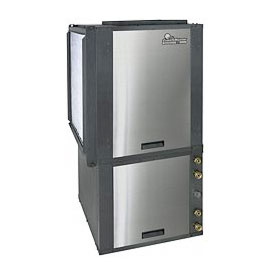Blog Post
Ground-Source Heat Pumps

Last week I introduced heat pumps and described how they can deliver more heat than is contained in the electricity they consume--while being able to provide cooling as well as heating. I mentioned two different types of heat pumps: air-source and ground-source. This week I'll cover ground-source (also known as "geothermal" and "geo-exchange") heat pumps.
All heat pumps rely on a "heat source" during the winter months and a "heat sink" in the summer where unwanted heat can be dumped. While air-source heat pumps use the outside air as the heat source and heat sink, ground-source heat pumps use the ground, or sometimes a body of water, for these functions.
The advantage of using a ground source for this heat exchange is that temperatures more than five feet underground are much warmer than the outside air during the winter and much cooler than the outside air during the summer, so the heat pump operates more efficiently. Put a different way, there's more heat to extract from this source in winter, and there's a greater capacity to absorb unwanted heat in the summer.
Some ground-source heat pumps have "closed loops" of buried tubing through which fluid is circulated--either water or a water-antifreeze solution--to exchange heat with the ground. This tubing can either be laid in horizontal trenches or vertically in wells, depending on the land area available and the character of the soils or rock. (With a water-source heat pump--a specialized type of ground-source heat pump--a coil of tubing typically sits in the water.) Some heat pumps have "open loops" in which water from a well or lake is pumped to the house, and then returned after the heat-exchange process.
No matter the configuration, the actual heat exchange in the heat pump usually happens in a unit inside the house. It is here that a refrigerant alternately evaporates and condenses and heat is transferred either into or out of the air being circulated through ducts to warm or cool the house. In a slight variation of this, "direct-exchange" ground-source heat pumps have the refrigerant flow through copper tubing that is buried, so the heat exchange is more direct; I won't get into the specifics of how these systems differ.
The big advantage of ground-source heat pumps is higher efficiency--somewhat higher than air-source heat pumps and much higher than electric-resistance heat. The disadvantage is cost. In our area, a typical ground-source heat pump may cost $35,000 or more; I have heard of local houses where systems costing as much as $70,000 were installed.
SUPPORT INDEPENDENT SUSTAINABILITY REPORTING
BuildingGreen relies on our premium members, not on advertisers. Help make our work possible.
See membership options »This gets back to a point I made last week--and often make. In new construction, I believe that it makes a whole lot more sense to take a chunk of the money that would be spent on an expensive heating system--whether a ground-source heat pump, a radiant-floor heating system, or a high-tech European pellet boiler--and instead put that money into the house envelope.
If you're considering a $35,000 ground-source heat pump, take $30,000 of that and put it into R-40 walls, R-60 ceilings, R-30 foundations, careful air sealing, and triple-glazed windows with two low-e coatings. By doing this, you'll get your heating loads down so low that a much simpler heating system can satisfy your needs and provide perfectly adequate comfort. That heating system might be a through-the-wall-vented gas space heater, a pellet stove, electric-resistance baseboard heat, or an air-source heat pump, such as the new-generation "mini-split" systems that I'll cover next week.
In new houses where only standard insulation levels are planned (R-20 walls, R-40 ceilings, and double-glazed low-e windows, for example) and with existing houses, the heating loads will be much higher, so spending a lot of money for a highly efficient heating system can be justified. In this situation, a ground-source heat pump may make sense.
Published April 14, 2009 Permalink Citation
(2009, April 14). Ground-Source Heat Pumps. Retrieved from https://www.buildinggreen.com/blog/ground-source-heat-pumps-0



Add new comment
To post a comment, you need to register for a BuildingGreen Basic membership (free) or login to your existing profile.